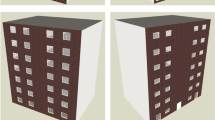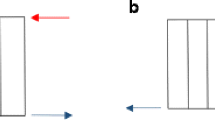Abstract
In Flanders, an obligatory software tool (EPR) is used to assess the energy performance of new buildings offering a simplified procedure to estimate the energy use for heating. This calculation approach is based on the principle of multiplying the building’s heating demand with standardised (sub)system efficiencies. In this paper, the accuracy of this simplified approach is assessed for a traditional, hydronic heating system in non-residential buildings. To do so, integrated dynamic simulations are performed in TRNSYS for a series of building design variants with varying insulation quality, thermal capacity, window-to-wall ratio and orientation. From the integrated simulations, monthly subsystem efficiencies are deduced. Results show that the efficiencies are significantly influenced by the part load ratio. As however losses of efficiencies are noticed only in periods of low heat demands, the overall effect on the annual use is limited. Energy assessment by the simplified method is within an error of <2.5 kWh/(m2·a) or <10%. Therefore, the simplified approach as currently applied in the EPR calculation tool in Flanders is concluded to be suited for the calculation of the final energy use. An evaluation of tabulated values for the overall system efficiencies used in this simplified method is however recommended.
Access this chapter
Tax calculation will be finalised at checkout
Purchases are for personal use only
Similar content being viewed by others
Notes
- 1.
Flanders has a temperate maritime climate influenced by the North Sea and the Atlantic Ocean with relatively moderate summers and mild winters. Moreover, schools are closed during July and August.
- 2.
An exhaust ventilation system, used for hygienic ventilation and passive cooling, is commonly found in contemporary Flemish schools (Wauman 2015) though is less typical for office buildings. Nevertheless, as the study focuses on heating systems (see Sect. 7.1) and a hydronic heating system with radiators is regularly found in office buildings, the same HVAC system is selected for both building typologies.
- 3.
Class rooms and canteens typically require high ventilation rates (see Table 7.4).
- 4.
The star temperature, as used in TRNSYS (Klein et al. 2010), is the weighted average of the zone air temperature and the surface temperatures of the walls surrounding the zone. This star temperature differs from the operative temperature, which also is a weighted average of the air and mean radiant temperature, but with the weighing factor set equal to 0.5.
References
ASHRAE (2009) ASHRAE fundamentals
Ast H (1986) IEA—annex 10: thermostatic valves. Technical report. Stuttgart, Germany, Institut fur Kernenergetik un Energiesysteme, abt. Heizung, Luftung-Klimattechnik, Universitat Stuttgart
Bauer M (1999) Methode zur Berechnung und Bewertung des Energieaufwandes fur die Nutzenubergabe bei Warmwasserheizanlagen. PhD thesis. Universitat Stuttgart, Germany
BBRI (2001) Kantoor 2000—Studie van energiegebruik en binnenklimaat van kantoren (in Dutch). Technical report
Breesch H (2006) Natural night ventilation in office buildings. PhD UGent, Belgium, Ghent, Belgium
Crawley DB, Hand J, Kummert M, Griffith BT (2005) Contrasting the capabilities of building energy performance simulation programs (version 1.0). Technical report, July, US Department of Energy, University of Strathclyde Energy Systems Research Unit, University of Wisconsin Solar Energy Laboratory, National Renewable Energy Laboratory
De Deygere M, Troch E (2013) Studie naar kostenoptimale energieprestatie- eisen bij niet-residentiele gebouwen (in Dutch). Technical report. Brussel, Belgie, Vlaams Energie Agentschap (VEA)
Debruyne R (2013) Rapport nr. 14: ontwerp en dimensionering van centrale-verwarmingsinstallaties met warm water (in Dutch). Technical report 14. Brussels, Belgium, WTCB
DIN V 4701-10 (2003) Energy efficiency of heating and ventilation systems in buildings—part 10: heating, domestic hot water, ventilation. no. 0033
EN 15251 (2007) Indoor environmental input parameters for design and assessment of energy performance of buildings addressing air quality, thermal environment, lighting and acoustics
EN 15316-2-3 (2007) Heating systems in buildings—method for calculation of system energy requirements and system efficiencies—part 2–3: space heating distribution systems
EN 15316-2-1 (2007) Heating systems in buildings—method for calculation of system energy requirements and system efficiencies—part 2–1: space heating emission systems
EN 15316-4-1 (2008) Heating systems in buildings. Method for calculation of system energy requirements and system efficiencies. Space heating generation systems, combustion systems (boilers)
EPBD (2018) The revised energy performance of buildings directive (EU) 2018/844
Haller M, Konersmann L, Haberl R, Droscher A, Frank E (2009) Comparison of different approaches for the simulation of boilers using oil, gas, pellets or wood chips. In: 11th international IBPSA conference, Glasgow, Schotland, pp 732–739
Holst S (1996) TRNSYS—models for radiator heating systems, Munchen, Germany
ISO 7730 (2005) Ergonomics of the thermal environment—analytical determination and interpretation of thermal comfort using calculation of the PMV and PPD indices and local thermal comfort criteria. http://linkinghub.elsevier.com/retrieve/pii/S0267726105000503
Klein SA, Beckham WA, Mitchell DW (2010) TRNSYS 17.1: a transient system simulation program. Solar Energy Laboratory, University of Wisconsin, Madison, USA
Korolija I (2011) Heating, ventilating and air-conditioning system energy demand coupling with building loads for office buildings. PhD De Montfort University, Leicester, UK
Korolija I, Marjanovic-Halburd L, Zhang Y, Hanby V (2013) UK office buildings archetypal model as methodological approach in development of regression models for predicting building energy consumption from heating and cooling demands. Energy Build 60:152–162. http://linkinghub.elsevier.com/retrieve/pii/S0378778812006810
Meteonorm ( 2005) Meteotest. Meteonorm versie 5.1 - Edition 2005
NBN EN 12831 (2003) Verwarmingssystemen in gebouwen - Methode voor de berekening van de ontwerp- warmtebelasting
NBN EN 13779 (2010) Ventilation for non-residential buildings—performance requirements for ventilation and room-conditioning systems (in Dutch)
NBN D 30-001 (1991) Centrale verwarming, ventilatie en luchtbehandeling - Gemeenschappelijke eisen voor alle systemen - Warmtegeneratoren en branders
Parys W (2013) Cost optimization of cellular office buildings based on building energy simulation. PhD, KU Leuven, Belgium, Leuven, Belgium
Peeters L, Van der Veken J, Hens H, Helsen L, D’haeseleer W (2008) Control of heating systems in residential buildings: current practice. Energy Build 40(8):1446–1455. http://linkinghub.elsevier.com/retrieve/pii/S0378778808000315
Pernigotto G (2013) Evaluation of building envelope energy performance through extensive simulation and parametrical analysis. PhD University of Padova, Italy
Shahrestani M, Runming Y, Cook GK (2013) Characterising the energy performance of centralised HVAC&R systems in the UK. Energy Build 62:239–247. http://linkinghub.elsevier.com/retrieve/pii/S0378778813001849
Tchervilov L, Kaloyanov NG (2012) Study on energy efficiency in buildings in the contracting parties of the energy community—final report. Technical Report, February, Energy Saving International AS (ENSI)
Van der Veken J, Hens H (2008) Determination of the heating efficiency at building level. In: building physics symposium, Liege, Belgium, pp 101–104
Van der Veken J, De Meulenaer V, Hens H (2006) Eindrapport GBOU - EL2EP PROJECT: Ontwikke- ling via levenscyclusoptimalisatie van extreem lage energie- en pollutiewoningen (in Dutch). Technical report
Van der Veken J, Creylman J, Lenaerts T (2013) Studie naar kostenoptimale niveaus van de minimumeisen inzake energieprestaties van nieuwe residentiele gebouwen (in Dutch). Technical Report april. Geel, Belgium: Kenniscentrum Energie, Thomas More Kempen/KU Leuven
Van Dijk HAL, Spiekman ME (2004) Energy performance of buildings: outline for harmonised EP procedures (ENPER - TEBUC). Technical report. Delft, The Netherlands, TNO Building and Construction Research
Van Dijk HAL, Spiekman ME, De Wilde PA (2005) A monthly method for calculation energy performance in the context of European building regulations. In: 9th international IBPSA conference, Montreal, Canada, pp 255–262
VEA (2011) Bijlage XII: Systeemeisen (in Dutch). Brussels, Belgium
VEA (2015) Annex VI Bepalingsmethode van het peil van primair energieverbruik van kantoor- en school- gebouwen (in Dutch). Brussels, Belgium
VEA (2017) Annex V Bepalingsmethode van het peil van primair energieverbruik van woongebouwen. Brussels, Belgium
Wauman B (2015) Evaluation of the quasi-steady-state method for the assessment of energy use in school buildings. PhD thesis, KU Leuven
Wauman B, Saelens D, Breesch H (2015) The definition of representative boundary conditions for Flemish schools for use in energy assessment methods. Energy Build 87:1–13. http://linkinghub.elsevier.com/retrieve/pii/S0378778814008780
Wilkins C, Hosni MH (2000) Heat gain from office equipment. ASHRAE J 42:33–44. New York
Zhang Y, Wright JA, Hanby VI (2006) Energy aspects of HVAC system configurations—problem definition and test cases. HVAC R Res 12(3C):871–888
Author information
Authors and Affiliations
Corresponding author
Editor information
Editors and Affiliations
Rights and permissions
Copyright information
© 2019 Springer Nature Singapore Pte Ltd.
About this chapter
Cite this chapter
Wauman, B., Parys, W., Breesch, H., Saelens, D. (2019). Evaluation of a Simplified Calculation Approach for Final Heating Energy Use in Non-residential Buildings. In: Motoasca, E., Agarwal, A., Breesch, H. (eds) Energy Sustainability in Built and Urban Environments. Energy, Environment, and Sustainability. Springer, Singapore. https://doi.org/10.1007/978-981-13-3284-5_7
Download citation
DOI: https://doi.org/10.1007/978-981-13-3284-5_7
Published:
Publisher Name: Springer, Singapore
Print ISBN: 978-981-13-3283-8
Online ISBN: 978-981-13-3284-5
eBook Packages: EnergyEnergy (R0)




